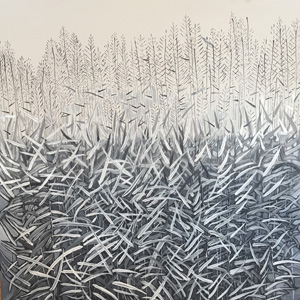
Jaroslava Bičovská: Black and white Fugue, 2017
| Curator: | Linda K. Sedláková |
|---|---|
| Venue: | Galerie Gema, Máchova 27, Praha |
| Dates: | 6. 10. - 17. 11. 2017 |
| Contact: | www.gemagalerie.cz |
| Opening hours: | Mon - Fri 13:00 - 18:00 |

| Curator: | Linda K. Sedláková |
|---|---|
| Venue: | Galerie Gema, Máchova 27, Praha |
| Dates: | 6. 10. - 17. 11. 2017 |
| Contact: | www.gemagalerie.cz |
| Opening hours: | Mon - Fri 13:00 - 18:00 |
born August 12, 1945 in Brandýs nad Labem
Jaroslava Bičovská tended to graphics and drawing from the very beginning. She started at the Vyšehrad publishing house, first as an administrative worker and later as a technical and art editor. Here she began to illustrate her first books. But then she got married, lived in Brandýs nad Labem, devoted herself to maternity duties and suddenly lost all contact with Prague and art. She couldn't find a job after her maternity leave for a long time, until she finally started inventing and drawing for the magazine ''Our Family'' very successful picture stories for children. Thy were even published in the children's magazine Osama in Syria for 1 year. Over the years, her interest turned more and more to free painting. In 1976, she built a small studio and decided to leave comics and devote herself fully to painting. However, the graduate of the graphic school learned it herself, so no one made it easier for her to take the first steps in mastering the new technology. They consider David Hockney and Hans Hartung as their role models, whose paintings are conceived on the line, which was very close to her - an essential artist. Already the first figural paintings from the 1980s, in a very dark tone, depicting especially the figures of musicians and comedians, revealed the special dream world of Jaroslava Bičovská, oscillating between realism and abstraction. found hyperrealistically presented figures hovering in an abstract environment that touches on the results of their activities. In the 1989 Jamsession painting, there is almost tangible music surrounding the depicted musicians. In the 1990s, the abstract lines in Bičovská's paintings took on a stronger breath, but the captivating atmosphere remained. Musical motifs remained (Unison, Da capo, Silensio, Solo ...) because thanks to the pianist's mother, the music is very deeply rooted in Bičovská. In addition, the themes of action, movement and transformation (Sprout, Revelation, Sign, Early Evening ...) appeared.
At that time, Bičovské also began to open a hitherto inaccessible world beyond the borders. Before the revolution, she got thanks to her marriage to Dr. Charif Bahbouh, CSc., Originally from Syrian, "only" to the Arab world - Syria, Lebanon and Algeria. The local culture got under her skin, especially calligraphy, which was very close to her (Record of a beautiful day, Visit to Damascus ...) In 1990 she and her husband founded Dar Ibn Rushd, a publishing house focused on publishing publications from the Arab world. Jaroslava Bičovská typographically edited and designed the covers, and illustrated many of them. When drawing, she uses a special technique, where she first engraves the drawings into paper, and then he reaches for the pencil and colors. The line seems too specific to her and she defies absolute realism by engraving. After the year 2000, the color palette changed, perhaps partly due to the safe mastery of painting techniques, Bičovská chooses bright to bright colors. The new work is represented by small watercolors and canvases, which return to the border of abstraction and reality after a purely abstract period. They radiate the unadulterated joy of living, of seeing the beauty around them and the certainty of painterly. Bičovská captures everything close to it - the landscape around the river in Brandýs nad Labem, the castle park or her own garden. At the exhibition in the New Hall in 2014, in addition to expressively colored works, six black-and-white drawings appeared, which breathed their attention to all visitors with their uncompromising clean line. In them, Bičovská showed how firmly she holds the reins of lines and contours in her hands and how precisely, without unnecessary "speech", she is able to capture the essence and mood of things. Over time, the number of black-and-white drawings increased, and at first a small trickle became a strong, flowing river. In 2016, the tribal gallery of Jaroslava Bičovská Gema Gallery, after years it reopened its own exhibition hall and it was obvious that the author would offer an exhibition soon. But not just any - pure black and white, including canvases! In our opinion, the author was not afraid of this challenge and the exhibited works are clear proof of that.
Linda K. Sedláková